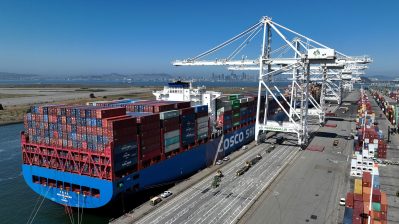
How Trump will wrangle the executive bureaucracy

The executive branch of government is a vast bureaucracy 2.6 million people strong. If you throw in the military, it’s more than 4 million, not counting untold numbers of contractors. Collectively, this bureaucracy administers a budget of more than $5 trillion. And sitting right on top will be Donald Trump.
The executive branch of today would probably be unrecognizable to the Founding Fathers.
“The founders did not anticipate an executive as large and powerful as we have today,” said Eric Posner, professor of law at the University of Chicago. We have Franklin Delano Roosevelt to thank, in part. “Before the New Deal, the general understanding was that regulation would mostly take place through the states. During the depression, FDR created a new type of federal bureaucracy that’s much more powerful and requires a lot more people,” Posner said.
As the economy and life generally became more complicated, the government kept up. We got the EPA under Richard Nixon, FEMA and the Department of Energy under Jimmy Carter.
“Congress created these regulatory agencies,” Posner said, “to make policy so Congress wouldn’t have to.”
How does a president make such a mammoth entity his or her own? How does one person manage such a thing?
“The answer is they don’t, but they try,” said David Lewis, professor of political science at Vanderbilt University.
The first, and perhaps obvious, way to get hold of the bureaucracy is to hire people to do it for you.
“There are 3,000 to 4,000 appointed positions, and their success at selecting people for these positions will determine how successful they are at controlling what these agencies do,” Lewis said.
But finding the right people, and finding the right people with management experience, is hard.
“President Kennedy said ‘I thought I knew a bunch of people, but it turned out I just knew a bunch of politicians,’” said Posner, quoting the 35th president.
Appointees may be loyal, or they may have their own agendas. This is aside, of course, from career civil-service employees who may actively resist a president’s efforts; people can resign, obstruct, whistleblow.
And presidents can’t appoint absolutely anyone they want.
“They also have to be beholden to other considerations, whether it’s the preference of the Senate or different factions in their party or key groups they made promises to in the campaign.”
Managing a bureaucracy by finding other people to do it for you is one thing. But how to manage a bureaucracy well? That’s different.
“We were confronted with the question,” Morley Winograd said. He was a senior policy adviser to Al Gore and director of the National Partnership for Reinventing Government. This was a Clinton-era program for government reform.
“There’s four p’s, if you will, a president worries about: politics, public relations, policy and performance. And performance for every president always ranks last,” he lamented.
There isn’t, for example, a regular bureaucracy performance briefing like there is for national security or economics.
“It’s not at the top of the agenda because it appears to have the least impact on the question that most politicians are most interested in, which is ‘How do I get re-elected?’” Winograd pointed out this is a bad assumption for a politician to make.
Good management starts, he said, with just paying attention to it.
“Make sure it’s a priority on their list of things to do,” he said. “Not on the legislative side of things, but in the calendar, the face time, the precious resource of a daily calendar.”
Put someone in charge of performance, he said, someone with direct access to the president. For Bill Clinton, that was Al Gore. Presidents Bush and Obama had something called the President’s Management Council, which advises the president on performance.
“Most importantly, have the highest quality, most current reliable data,” he added.
Reliable data on performance has proved a challenge at the federal level.
But difficulties aside, as unruly as the executive branch can be, the fact that the executive branch is so sprawling and difficult to get a grip on is actually the source of one of the president’s powers.
“The executive branch is so gigantic that the president is not going to be able to control most of what it does, it’s just going to continue doing what it’s done in the past,” Posner said . “But he can pick a few things that he cares about a lot” and focus on them.
Does a president emphasize border control or health and human services? The IRS or the EPA? Obama’s controversial decision to suspend enforcement of certain immigration rules is a prime example. George W. Bush’s appointment of Michael Brown to head FEMA is another.
In some ways, the part of the bureaucracy a president grabs hold of can define their legacy.
Click the below audio player to hear more on the complications of managing the executive bureaucracy:
There’s a lot happening in the world. Through it all, Marketplace is here for you.
You rely on Marketplace to break down the world’s events and tell you how it affects you in a fact-based, approachable way. We rely on your financial support to keep making that possible.
Your donation today powers the independent journalism that you rely on. For just $5/month, you can help sustain Marketplace so we can keep reporting on the things that matter to you.


















